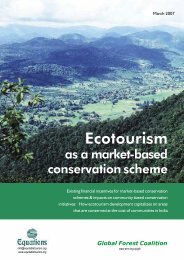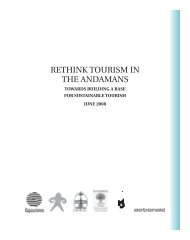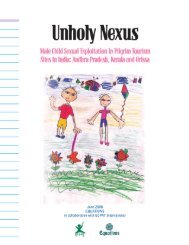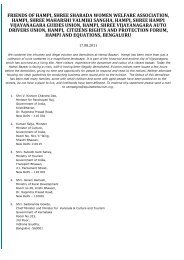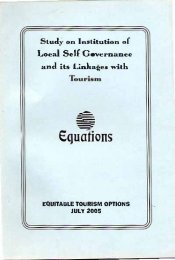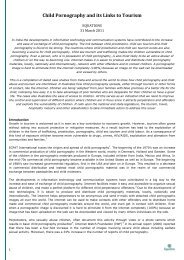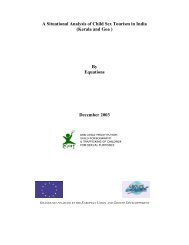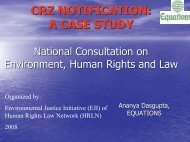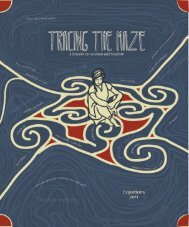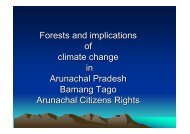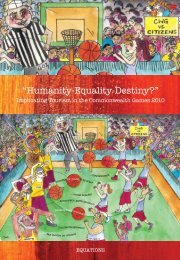Note to be read in conjuction with analysis of ecotourism guidelines
Note to be read in conjuction with analysis of ecotourism guidelines
Note to be read in conjuction with analysis of ecotourism guidelines
Create successful ePaper yourself
Turn your PDF publications into a flip-book with our unique Google optimized e-Paper software.
<strong>Note</strong> on Eco<strong>to</strong>urism – <strong>to</strong> <strong>be</strong> <strong>read</strong> <strong>in</strong> conjunction <strong>with</strong> EQUATIONS Analysis<strong>of</strong> (Draft) Guidel<strong>in</strong>es for Eco<strong>to</strong>urism In and Around Protected Areasissued by the M<strong>in</strong>istry <strong>of</strong> Environment and Forests onJune 2, 2011Tourism is complex and has social, cultural, economic and political implications for both the <strong>to</strong>urism dest<strong>in</strong>ation aswell as for the country.Complicat<strong>in</strong>g this further is the concept <strong>of</strong> eco<strong>to</strong>urism, which stands for ‘ecological <strong>to</strong>urism’. To understandeco<strong>to</strong>urism, it is necessary <strong>to</strong> unpack both these words.EcologyThe term ecology was first <strong>in</strong>troduce by a biologist Haeckel who def<strong>in</strong>ed it as “… the study <strong>of</strong> the economy, <strong>of</strong> thehousehold, <strong>of</strong> animal organisms. This <strong>in</strong>cludes the relationships <strong>of</strong> animals <strong>with</strong> both the <strong>in</strong>organic and organicenvironments, above all the <strong>be</strong>neficial and <strong>in</strong>imical relations that Darw<strong>in</strong> referred <strong>to</strong> as the conditions <strong>of</strong> the strugglefor existence”. The understand<strong>in</strong>g <strong>of</strong> human ecology is subsumed <strong>with</strong><strong>in</strong> the broader term <strong>of</strong> ecology. Theunderstand<strong>in</strong>g <strong>of</strong> ecology <strong>in</strong> itself requires a multi-sec<strong>to</strong>ral lens. The understand<strong>in</strong>g <strong>of</strong> human ecology <strong>in</strong> particularwould need <strong>to</strong> draw from anthropology, sociology, economics, geography and biology 1 .TourismThere are 4 basic features <strong>of</strong> <strong>to</strong>urism: <strong>to</strong>urism is subject <strong>to</strong> commoditization, private capital alone is not sufficient andstate <strong>in</strong>tervention is needed <strong>to</strong> fulfil the vision for <strong>to</strong>urism (<strong>in</strong> the case <strong>of</strong> capitalist economies, this could <strong>be</strong> <strong>in</strong> theform <strong>of</strong> a mix <strong>of</strong> the public and private sec<strong>to</strong>r) and <strong>to</strong>urism necessarily sees privatisation. Further it has <strong>be</strong>enestablished that <strong>to</strong>urism is a product which is subject <strong>to</strong> issues <strong>of</strong> consumption i.e. demand and supply 2 .Tourism is itself a multi stakeholder sec<strong>to</strong>r <strong>with</strong> those <strong>of</strong>fer<strong>in</strong>g direct and ancillary services therefore requir<strong>in</strong>g <strong>in</strong>terconnectedness<strong>be</strong>tween the relevant m<strong>in</strong>istries and departments at the centre and the state. Additionally, a large par<strong>to</strong>f this sec<strong>to</strong>r is <strong>in</strong>formal <strong>in</strong> nature mak<strong>in</strong>g regulation a challenge as well as an imperative.Tourism like all other sec<strong>to</strong>rs <strong>in</strong> the services <strong>in</strong>dustry is not immune <strong>to</strong> social and cultural hierarchies. Given the broadspectrum <strong>of</strong> stakeholders, very <strong>of</strong>ten their <strong>be</strong>nefits are also <strong>in</strong> competition and at logger heads <strong>with</strong> each other.The eco<strong>to</strong>urism that is <strong>be</strong><strong>in</strong>g promoted by the guidel<strong>in</strong>es are merely us<strong>in</strong>g nature as a <strong>to</strong>urism product, which doesnot make it eco<strong>to</strong>urism. With the suggestion that <strong>to</strong>urism <strong>be</strong> taken out <strong>of</strong> the parks and <strong>in</strong><strong>to</strong> the buffer areas, what isemerg<strong>in</strong>g is <strong>to</strong>urism which is rural and nature-based, and therefore could <strong>be</strong> termed as nature-based rural <strong>to</strong>urism,rather than eco<strong>to</strong>urism.Political connotations <strong>of</strong> eco<strong>to</strong>urismEco<strong>to</strong>urism, <strong>to</strong>day is largely <strong>in</strong>terpreted as nature based <strong>to</strong>urism <strong>with</strong> the additional requirement <strong>of</strong> sensitivity andresponsibility <strong>to</strong>wards the delicate balance <strong>in</strong> nature. Eco<strong>to</strong>urism is also <strong>be</strong><strong>in</strong>g used as a market-based conservationmechanism <strong>in</strong> the context <strong>of</strong> climate change and the UNFCCC as is evident <strong>in</strong> the REDD implementation mechanism <strong>in</strong>India, which is the Green India Mission.Post 2006, when tiger reserves received directions <strong>to</strong> notify buffer and core, the <strong>to</strong>tal area <strong>of</strong> the tiger reserves have<strong>in</strong>creased. This is also <strong>in</strong> consonance <strong>with</strong> the attempt <strong>to</strong> <strong>in</strong>crease forest cover <strong>in</strong> the context <strong>of</strong> the climate changedebate. In India, the mechanism that has <strong>be</strong>en evolved is the Green India Mission, which aims at <strong>in</strong>creas<strong>in</strong>g theforest cover <strong>in</strong> the country <strong>to</strong> 20 million hectares. The proposed guidel<strong>in</strong>es seem <strong>to</strong> <strong>be</strong> attempt<strong>in</strong>g this by stipulat<strong>in</strong>gthat farms <strong>be</strong> converted <strong>to</strong> forests and that buffer areas <strong>be</strong> res<strong>to</strong>red <strong>to</strong> wildlife habitats Act. To have its provisionspotentially la<strong>be</strong>lled as trade-restrictive might grant immunity <strong>to</strong> service providers <strong>in</strong> the <strong>to</strong>urism <strong>in</strong>dustry fromperform<strong>in</strong>g their duties under this Act. It can <strong>be</strong> speculated as <strong>to</strong> what proportion <strong>of</strong> this <strong>in</strong>vestment <strong>in</strong> <strong>to</strong>urism is<strong>be</strong><strong>in</strong>g or will <strong>be</strong> facilitated by the GATS. But undoubtedly its discipl<strong>in</strong>es on domestic regulation might consider suchregulation trade-restrictive and violat<strong>in</strong>g GATS commitments and possible deny state governments their constitutionalright <strong>to</strong> pass such regulations <strong>in</strong> the future.1
There are several case studies 3 which highlight communities’ role <strong>in</strong> conservation. Yet the debate <strong>to</strong>day focuses onprivate sec<strong>to</strong>r contribution for conservation <strong>in</strong> the name <strong>of</strong> ecosystem services that forests <strong>of</strong>fer. It is <strong>in</strong>fact thiscommoditisation <strong>of</strong> forests which is the problem and which eco<strong>to</strong>urism <strong>in</strong> its limited way furthers. Forests are morethan carbon s<strong>in</strong>ks and providers <strong>of</strong> ecosystem services. They are homes <strong>to</strong> diverse communities <strong>with</strong> a rich culturalheritage <strong>of</strong> conservation.The guidel<strong>in</strong>es clearly mention that they are meant for eco<strong>to</strong>urism ventures <strong>in</strong> and around protected areas. Here<strong>in</strong>lies the <strong>be</strong>g<strong>in</strong>n<strong>in</strong>g <strong>of</strong> the problem. What about eco<strong>to</strong>urism <strong>in</strong> forest areas which are not reserves? Is there no need forsusta<strong>in</strong>able <strong>to</strong>urism development <strong>in</strong> these areas?Furthermore, as mentioned above the creation <strong>of</strong> protected areas mandates ruthless ‘voluntary’ displacement <strong>of</strong>communities who have for centuries <strong>be</strong>en the cus<strong>to</strong>dian <strong>of</strong> the forests. The Scheduled Tri<strong>be</strong>s and Other TraditionalForest Dwellers (Recognition <strong>of</strong> Forest Rights) Act, 2006 reiterates and re-establishes this relationship <strong>be</strong>tweenforests and forest dwell<strong>in</strong>g communities. Yet the manner <strong>in</strong> which Critical Wildlife Habitats and Critical Tiger Habitatsare identified and demarcated does not take this <strong>in</strong><strong>to</strong> consideration. Several forest based groups have highlighted theissues perta<strong>in</strong><strong>in</strong>g <strong>to</strong> this and we support their criticisms on the same.The guidel<strong>in</strong>es highlight 2 important l<strong>in</strong>kages <strong>to</strong> eco<strong>to</strong>urism:a. Eco<strong>to</strong>urism and conservationb. Eco<strong>to</strong>urism and community developmentWe refute the above claims <strong>in</strong> this note. Eco<strong>to</strong>urism if conducted <strong>in</strong> a planned manner, can generate funds forconservation. However, it does not directly lead <strong>to</strong> conservation, which needs for more specialised methods.In the context <strong>of</strong> livelihoods, eco<strong>to</strong>urism can only generate employment and for communities it is employment at thelower end <strong>of</strong> the hierarchical corporate ladder. There is a very important contradiction and difference <strong>be</strong>tweenlivelihood and employment.Livelihood is a much broader sociological term rooted the concept <strong>of</strong> social justice where culture and identity form itsbasis and is dependent upon the landscape and ecology. It is connected <strong>with</strong> community and property rights<strong>in</strong>dicat<strong>in</strong>g dignity, control, empowerment and susta<strong>in</strong>ability apart from <strong>in</strong>come generation.Employment on the other hand is an economic term denot<strong>in</strong>g work done and money earned. It is <strong>in</strong>dividualistic,governed by a set <strong>of</strong> rules <strong>be</strong>tween two <strong>in</strong>dividuals/entities where capital dom<strong>in</strong>ates and is irrespective <strong>of</strong> anylocation/landscape/ecology and pays for labour that produces and reproduces for consumption for another and doesnot consider the issue <strong>of</strong> susta<strong>in</strong>ability.Eco<strong>to</strong>urism and conservationThe follow<strong>in</strong>g are some arguments made <strong>in</strong> favour <strong>of</strong> eco<strong>to</strong>urism’s contribution <strong>to</strong> conservation:a. Tourism generates funds for conservation related activities.EQUATIONS <strong>in</strong> an earlier paper had refuted this argument stat<strong>in</strong>g 4 :Estimat<strong>in</strong>g the costs <strong>of</strong> regeneration and the sources <strong>of</strong> funds received by the Forest Department is a difficult task.Firstly, identify<strong>in</strong>g and segregat<strong>in</strong>g different cost components is a challenge s<strong>in</strong>ce adm<strong>in</strong>istrative costs overlap variousactivities <strong>in</strong>clud<strong>in</strong>g conservation and management.Secondly, identify<strong>in</strong>g the source <strong>of</strong> resources is also a challenge. The Forest Department receives money from boththe state and central governments. There are several crores <strong>of</strong> funds parked <strong>in</strong> CAMPA, the utilisation <strong>of</strong> which has<strong>be</strong>en extremely low 5 . The Government <strong>of</strong> India is also receiv<strong>in</strong>g large amounts <strong>of</strong> fund<strong>in</strong>g from various InternationalF<strong>in</strong>ancial Institutions for forest regeneration.Fundamentally, the issue here is <strong>to</strong> exam<strong>in</strong>e if the <strong>in</strong>come generated from eco<strong>to</strong>urism activities do go back <strong>to</strong> theForest Department. Currently, all earn<strong>in</strong>gs from forests (NTFP, tim<strong>be</strong>r, entry fee etc.) go back <strong>in</strong><strong>to</strong> a common poolwhere<strong>in</strong> all non-plan <strong>in</strong>come <strong>of</strong> the state is parked, from where allocations for different expenses are made. There is2
no way <strong>to</strong> ensure that the <strong>in</strong>comes from <strong>to</strong>urism are ploughed back <strong>to</strong> the Forest Department for regeneration work.Therefore the only direct <strong>be</strong>nefit that is traceable is salaries people receive <strong>in</strong> case they are employed at <strong>to</strong>urismsites. This creates a rupture <strong>in</strong> the idea that eco<strong>to</strong>urism can <strong>be</strong> used as an <strong>in</strong>come generation method for forestconservation.b. Wildlife <strong>to</strong>urism creates awareness among the <strong>to</strong>urists who are visit<strong>in</strong>g therefore build<strong>in</strong>g publicsupport for conservation measures that the centre announces.The nature <strong>of</strong> wildlife <strong>to</strong>urism <strong>in</strong> India, is centred around the big mammals. Guides <strong>in</strong> different National Parks andWildlife Sanctuaries have shared that <strong>to</strong>urists are left unhappy and dissatisfied if a big mammal has not <strong>be</strong>en spotteddur<strong>in</strong>g a safari. For e.g <strong>in</strong> Kanha and Bandhavgarh, safari guides and drivers are focussed on track<strong>in</strong>g the tiger for the<strong>to</strong>urists and that <strong>to</strong>urists are not <strong>in</strong>terested <strong>in</strong> learn<strong>in</strong>g about the flora and fauna <strong>of</strong> the forests.Further, a rule exists that the distance <strong>be</strong>tween 2 jeeps dur<strong>in</strong>g a safari should <strong>be</strong> a m<strong>in</strong>imum <strong>of</strong> 500 metres.However, pho<strong>to</strong>graphs <strong>in</strong> the media show that this does not happen.Eco<strong>to</strong>urism and community developmentThe forests <strong>in</strong> the form <strong>of</strong> – protected areas, national parks, wildlife sanctuaries are the ma<strong>in</strong> <strong>to</strong>urism product <strong>in</strong>eco<strong>to</strong>urism. The creation <strong>of</strong> these areas have caused land alienation and displacement <strong>in</strong> large num<strong>be</strong>rs. This change<strong>in</strong> land use pattern and land dispossession, lack <strong>of</strong> access <strong>to</strong> forest resources has led <strong>to</strong> social <strong>in</strong>justices like loss <strong>of</strong>dignity and livelihoods <strong>of</strong> the adivasis and other forest dwellers. Therefore, <strong>in</strong> stark contrast <strong>to</strong> the claim thateco<strong>to</strong>urism furthers community development, it <strong>in</strong> fact bases itself on a paradigm <strong>of</strong> forest conservation andprotection, which has taken away the exist<strong>in</strong>g livelihoods <strong>of</strong> people.Through the narration <strong>of</strong> several examples, the Encyclopaedia <strong>of</strong> Eco<strong>to</strong>urism, corroborates this understand<strong>in</strong>g <strong>of</strong>eco<strong>to</strong>urism <strong>in</strong> the context <strong>of</strong> communities, which states 6 :“Eco<strong>to</strong>urism, therefore, has not proven itself <strong>to</strong> <strong>be</strong> the godsend for local communities that is claimed <strong>to</strong> <strong>be</strong> by somesupporters. This is a matter <strong>of</strong> great concern, given that the size and expectations <strong>of</strong> local communities, and hencethe demand for resources, is cont<strong>in</strong>u<strong>in</strong>g <strong>to</strong> <strong>in</strong>crease throughout most <strong>of</strong> the world.”Eco<strong>to</strong>urism and employmentIt is true that <strong>to</strong>urism development generates employment opportunities for the local communities. However theowners <strong>of</strong> these establishments whether lodge owners or jeep owners are usually not from the region. They are more<strong>of</strong>ten than not from nearby cities/<strong>to</strong>wns and sometimes are from as far away places like New Delhi, Kolkata andMumbai. The <strong>in</strong>come thus generated from <strong>to</strong>urism is taken away from the region and <strong>in</strong><strong>to</strong> the bigger cities. There isalso the issue <strong>of</strong> self-determ<strong>in</strong>ation here. People who used <strong>to</strong> own land, have due <strong>to</strong> poverty <strong>be</strong>en forced <strong>to</strong> sell out <strong>to</strong>the companies and <strong>be</strong>come employed as guides and drivers if lucky, but usually end up work<strong>in</strong>g as security guards,gardeners, waiters at the restaurant etc. Therefore the mere generation <strong>of</strong> employment, though an <strong>of</strong>ten repeatedargument, is highly overestimated as it does not counter the disempowerment and lack <strong>of</strong> dignified life that theadivasis experience.The Madhya Pradesh Eco<strong>to</strong>urism Development Board (MPEDB) has conducted a study on employment generated byeco<strong>to</strong>urism <strong>in</strong> Bandhavgarh 7 . The study shows that though 62% <strong>of</strong> the people <strong>in</strong>volved <strong>in</strong> <strong>to</strong>urism activity at Tala arelocal people, they are all largely <strong>in</strong>volved <strong>in</strong> the unorganised sec<strong>to</strong>r <strong>of</strong> drivers, cooks, labour, guide and generalbus<strong>in</strong>ess. 88% <strong>of</strong> the people <strong>of</strong> village Tala are <strong>in</strong>volved <strong>in</strong> this work. All the managerial level work is thereforeconducted by the outsiders. Further, <strong>in</strong> villages other than Tala, only 1% <strong>of</strong> the people are <strong>in</strong>volved <strong>in</strong> <strong>to</strong>urismactivities.This trend is corroborated <strong>in</strong> the study conducted by Karanth, K & DeFries, R (2010) where they state that less than0.001% <strong>of</strong> population liv<strong>in</strong>g <strong>with</strong> 10 kms <strong>of</strong> a PA f<strong>in</strong>d employment <strong>in</strong> the <strong>to</strong>urism <strong>in</strong>dustry 8 .Further, eco<strong>to</strong>urism is not a year-round activity s<strong>in</strong>ce it depends on the <strong>to</strong>urism season. All <strong>to</strong>urism can contribute <strong>to</strong>,is an alternate means <strong>of</strong> <strong>in</strong>come for a few months <strong>in</strong> a year. To shift the dependency <strong>of</strong> <strong>in</strong>comes <strong>of</strong> families on<strong>to</strong>urism, would <strong>be</strong> detrimental <strong>to</strong> their economic well <strong>be</strong><strong>in</strong>g.3
Eco<strong>to</strong>urism and LivelihoodToday, community-driven <strong>to</strong>urism <strong>in</strong>itiatives are still play<strong>in</strong>g a marg<strong>in</strong>al role and do not receive the impetus they needfrom the government through schemes and <strong>in</strong>centives. In the absence <strong>of</strong> this communities will not <strong>be</strong> able <strong>to</strong>compete <strong>with</strong> big opera<strong>to</strong>rs <strong>with</strong> the capacity <strong>to</strong> acquire large tracts <strong>of</strong> land and convert them <strong>in</strong><strong>to</strong> private forests,which are then promoted as <strong>to</strong>urism products <strong>in</strong> themselves. In fact, it is not mere schemes that are needed <strong>to</strong>ensure that <strong>to</strong>urism is community driven. What is needed is a change <strong>in</strong> the way eco<strong>to</strong>urism is envisaged – wherecommunities are central <strong>to</strong> the venture and not mere pr<strong>of</strong>its <strong>of</strong> large <strong>to</strong>ur opera<strong>to</strong>rs and <strong>in</strong>come for the nation.Furthermore, start<strong>in</strong>g a <strong>to</strong>urism enterprise might not even <strong>be</strong> the <strong>in</strong>terest <strong>of</strong> the community and the state would need<strong>to</strong> recognise and respect this.As mentioned above, a change <strong>in</strong> m<strong>in</strong>dset <strong>to</strong>wards eco<strong>to</strong>urism and communities is <strong>in</strong> order. The def<strong>in</strong>ition <strong>of</strong> <strong>to</strong>urismas propounded by TIES <strong>in</strong>cludes community-welfare. Eco<strong>to</strong>urism would need <strong>to</strong> go <strong>be</strong>yond community-welfare <strong>to</strong><strong>be</strong><strong>in</strong>g community-centered if it wants <strong>to</strong> achieve its goal <strong>of</strong> conservation and community development.End <strong>Note</strong>s1 Bates, D.G & Tucker, J (Eds.) (2010), “Human Ecology: Contemporary Research and Practice”, Spr<strong>in</strong>ger, New York2 Shaw, G & Williams, A.M. (1994), “Critical Issues <strong>in</strong> Tourism”, Blackwell Publishers, Massachusetts3 Documentation <strong>of</strong> Consultation on REDD <strong>in</strong> India organised by NFFPFW and EQUATIONS on ‘REDD Realities <strong>in</strong> India: Will the forests and forest peoplesurvive?’, Novem<strong>be</strong>r 20104 ‘Community Involvement <strong>in</strong> Eco<strong>to</strong>urism’, EQUATIONS, Decem<strong>be</strong>r 20105 Accord<strong>in</strong>g <strong>to</strong> the MoEF website on CAMPA, <strong>in</strong>come as on 31.1.2010 is Rs. 16,884,204,485 and the expenditure for the same period is Rs. 7,999,134 <strong>with</strong> a balance<strong>of</strong> Rs. 16,876,205,351. http://moef.nic.<strong>in</strong>/downloads/public-<strong>in</strong>formation/CAMPA-consolidated-<strong>in</strong>come-expen.pdf6 David B, Weaver (Ed.) (2001), “ The Encyclopedia <strong>of</strong> Eco<strong>to</strong>urism”, CABI Publish<strong>in</strong>g, U.K.7 “Contribution <strong>of</strong> Eco<strong>to</strong>urism <strong>to</strong> livelihood: Bandhavgarh National Park”, MPEDB8 Karanth, K & DeFries, R (2010) Nature-based <strong>to</strong>urism <strong>in</strong> Indian protected areas: New challengesfor park management, Conservation Letters4



